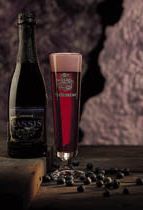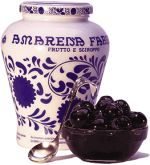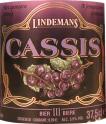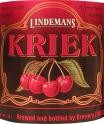| |
The fruit Lambics of Lindemans
by Willard Clarke, 08/04
Champagne-lovers will instantly feel at home when faced with one of these singular beers from the ancient family firm of Lindemans. With their Champagne look-alike bottles, complete with deep punt in the base and
foiled top, there is also the intriguing promise - or is it a threat? - of "Spontaneous Fermentation" declared on the label.
Since 1811, Lindemans have produce Lambic beers in the little town of Vlezenbeek, just south of Brussels. Lambic is one of the world's rarest and most unusual beer styles,
found only in this region of Belgium. Indeed, the Champagne bottle is no accident: Lambic beers seem closer to wine than beer in many respects. Partly this is down to a proportion of the beer being brewed from un-malted
wheat, so there is little malt character, and from the use of dried and aged hops, which impart relatively little hoppy flavour and bitterness. The beer's fermentation is also unusual, and is indeed "spontaneous", as it is achieved
solely with ambient yeasts, found in this part of Belgium, and alive in the cellars. Following fermentation, Lambic beers typically spend two years maturating in oak casks prior to release. They really are very wine-like beers, of
a particularly distinctive style.
|
|

|
After a relatively orthodox start to the beer-making process (apart from the un-malted wheat), at the stage when the wort would normally be inoculated with cultured yeast, it is instead poured into shallow tray-like vessels
and simply left in the attic rooms of the cool, Lambic cellars. Ambient yeasts (two strains of Brettanomyces) begin the fermentation. This is a seasonal beer, brewed in winter, as in summer there is too much risk from
bacterial spoilage.
Fruit-flavoured Lambics have been produced for generations. The original fruit Lambic was Kriek, made with a type of small, local cherry. It was found that the extra acidity of Lambic beers -from the un-malted wheat and
wild yeast character - made for a very sympathetic match with the sweetness of the fruits. Lindemans' Kriek is made the most traditional way, by adding fresh black cherries and pulp to a
barrel of Lambic about six months into its maturation. The addition of the sugary fruit creates a secondary fermentation in the barrel, and
after another year or so, when the fruit has been completely dissolved apart from the peel and stones, the beer is filtered and bottled. A little extra cherry juice is added to cause a tertiary fermentation in bottle
that also adds to the full, foaming mousse of the beer, in yet another nod towards Champagne style.
I found the Kriek to be terrifically evocative of family summer holidays in Italy many years ago, when most days ended in a seaside café with an ice-cream doused in
Amerena wild cherries: the beer has exactly this aroma. The Cassis beer from Lindemans is
fuller, darker and heavier, and though it lacks the edge of crispness of the Kriek, it is a striking drink. The final Lindemans I tried from this selection available in Oddbins, is Pecheresse, made with the addition of peach pulp.
At only 2.5% ABV it is a gorgeous drink, and absolutely the dream beverage for a lazy summer's day in the garden.
|
|

|
I have to say that the three fruit Lambics tasted below are most un-beer-like in many ways. Served blind, I'm not sure that I would have said they were beers at all. But beers they are, brewed from grain, hops, water and yeast, and given time
to adjust ones frame of reference, they are both delicious and unusual.
Lindemans, Cassis (Belgium) 
This beer pours a dark, vivid purple/black with a mauve-tinted head. On the nose there is a soaring cassis and fruit pastille character, with just a hint of something a little sour beneath. On the palate it is rich and mouthfilling, and an immediate flood of Ribena-like sweet blackcurrant washes over the tongue. This beer is noticeably heavier than the Kriek, with a weighty texture and a subtle undertow of toasty malt bread. The acidity is soft, but a suggestion of blackcurrant skin tartness does add some freshness on the finish. 3.5% ABV, 37.5cl, ?2.19, Oddbins.  |  |
Lindemans, Kriek (Belgium) 
Kriek is traditionally made with fresh local black cherries of the district, though some makers now use the pulp of the fresh cherries which extends the beer's season. This beer pours an astonishingly bright, garish purple pink with a vividly pink head. The nose is suffused with the aroma of cherries, very specifically of Amerena cherries and a little edge of Bazooka Joe bubblegum. There is a hint of wheat beer sourness in the background. On the palate it is dense and full, with loads of cherry fruited sweetness. This is just a fun drink, with little beer character to speak of, and some might look for a little more bite, it is delicious in its own way and once of the great beer experiences everyone should try. 3.5% ABV, 37.5cl, ?1.89, Oddbins.  |  |
Lindemans, Pecheresse (Belgium) 
The peach-flavoured Lambic is an extraordinarily light 2.5% ABV, and pours with a lovely orangy-peach colour and white head. On the nose this is the least fruity, with a distinct wheat-beer note. On the palate it is quite full and rolling, coating the palate with a sweet-edged blast of peach fruit, and a nicely sour tang of wheaty flavour and acidity. It is soft and easy to drink, but that little bite plays against the sweetness and keeps it very moreish. Because of that, that I slightly preferred this to the cassis, and it would be a sensational summer-in-the-garden drink with that low alcohol. For that purpose, it is excellent. 2.5% ABV, 37.5cl, ?2.15, Oddbins.  |  |
|
|